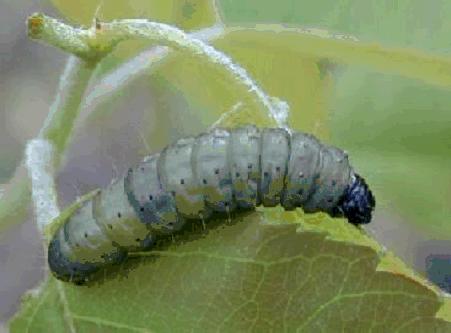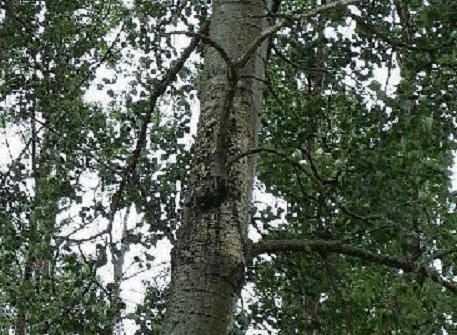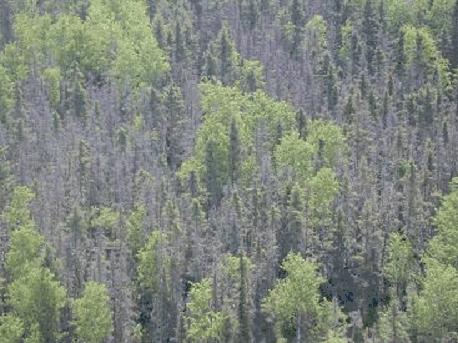| |
Woodlot Pest Management | |
| |
|
|
| |
|
|
| | Because woodlots require long-term management, it is important to understand that forests go through a cycle of change over time. Mammals, birds, insects, diseases, weather, and fire that weaken or kill individual trees are natural parts of forests that help with this change. A healthy forest is able to recover after a natural event like fire or insects, is able to support a variety of plants and animals and is resistant to extreme change like weather. However when there is a lack of balance and the overall health of the trees are threatened, this could be a sign of an unhealthy forest.
.

A major defoliator of poplars, large aspen torix larva (caterpillar) crawling on a leaf
Photo by: Mike Maximchuk- Alberta Sustainable Resource Development
Keeping the health and vigor of the woodlot is very important for land owners. Factors such as insects or disease that threaten the overall health of the trees and compete with us in the use of a forest are considered pests. Some pests cause only minor physical damage, while others limit growth or kill the trees. Careful planning by woodlot owners will reduce the risk of potential outbreaks. Early detection and control of serious problems will help reduce losses during pest outbreaks.
Cause of Damage
If a pest is suspected, it is important to identify probable causes. The Alberta Forest Pest Damage Diagnostic System (FPDDS) by Sustainable Resource Development may be able to help you identify common Alberta forest pests based on the damage you see. This system also allows you to search for more details of a known pest or tree. You can find out what pests could damage a given tree or what trees are vulnerable to a given pest. Also, you can look in the image gallery to compare pictures to your observed damage for a quick, visual identification.

Hypoxylon canker found on the stem of an aspen poplar
Photo by: Toso Bozic
Have the following information about your affected trees to help you narrow down the cause of damage:
1. tree type
2. approximate tree height for needle trees (conifers)
3. number of trees damaged (1 or many)
4. location of damage (roots; stem; branches; needles or leaves)
5. type of damage (signs and symptoms); look for:
a. unusual colour changes or wilting of needles or leaves in the summer
b. caterpillars, cocoons, eggs, webbing
c. chew marks or holes
d. mushrooms
e. anything that looks unusual, like sap dripping, bumps on the bark etc
Click here to go to the Alberta Forest Pest Damage Diagnostic System:
Next Step
Once the probable cause of the damage is identified, here are some important questions to consider before taking any action:
- Is the suspected pest/s a major pest?
- Can the pest spread to other areas?
- What is the extent and severity of the damage?
- How important is the type of tree affected?
- What is the overall impact on the woodlot?
- Can the pest be controlled in a safe effective and an economical manner?
- Can the forest be changed over time to reduce the impact of the pest? (e.g. removing highly susceptible tree types)
- What conditions of the woodlot could be making it unhealthy? (e.g. drought; over crowding)
- Can the forest conditions be improved to increase the health? (e.g. fertilizing, thinning or irrigation)

Standing, dead white spruce trees after years of severe spruce budworm defoliation.
Photo by: Mike Maximchuk- Alberta Sustainable Resource Development
For pesticide treatment options, contact your local horticulturist or Agriculture fieldman.
For more information on woodlot/agroforestry management please contact:
Toso Bozic
Woodlot Specialist/Agroforester
Toll free: 310-FARM (3276) or
Office: 310-0000 then dial 780-415-2681
E-mail: toso.bozic@gov.ab.ca
Other Related Links:
|
|
| |
|
|
| |
For more information about the content of this document, contact Toso Bozic.
This document is maintained by Brenda McLellan.
This information published to the web on May 21, 2004.
Last Reviewed/Revised on March 12, 2018.
|
|